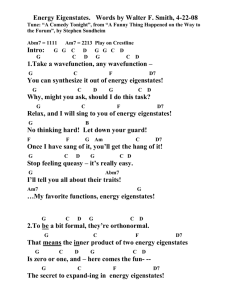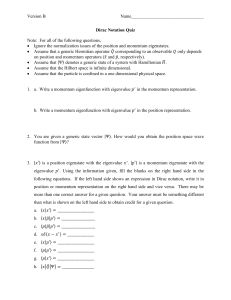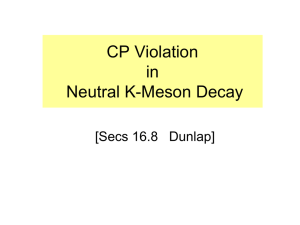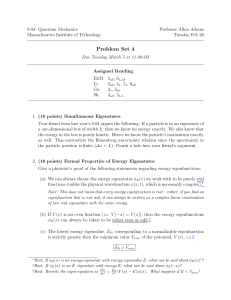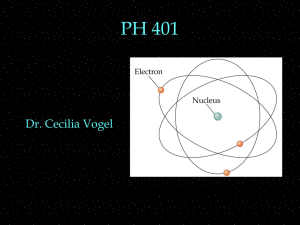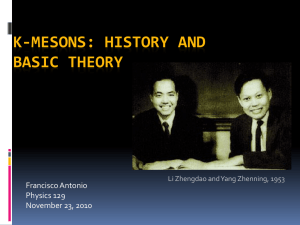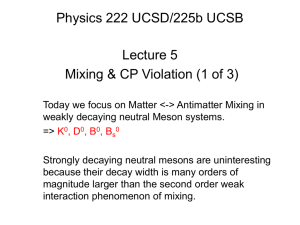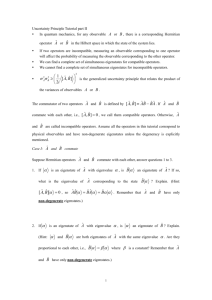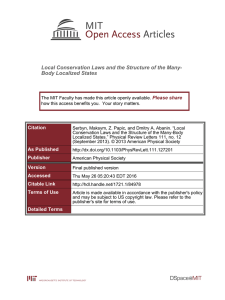spinors, matrix mechanics
advertisement
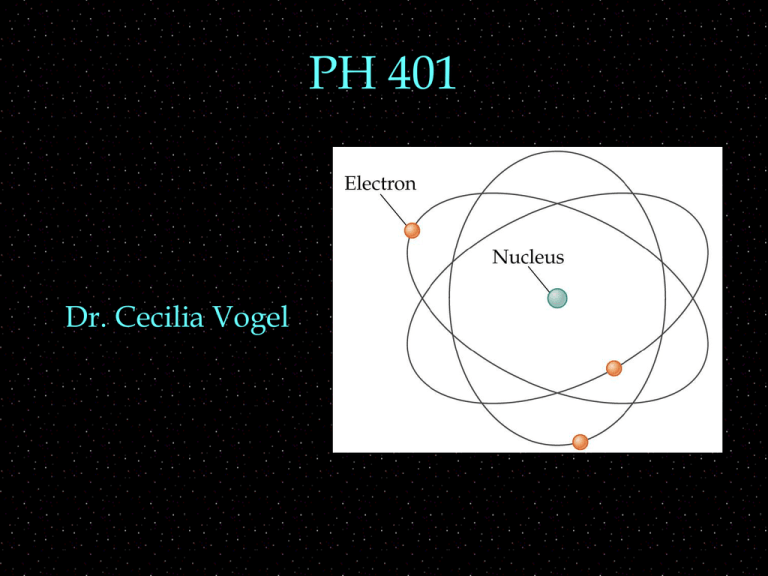
PH 401 Dr. Cecilia Vogel Review Resuscitating Schrödinger's cat Pauli Exclusion Principle EPR Paradox Outline Sx, Sy, Sz eigenstates spinors, matrix representation states and operators as matrices multiplying them Eigenstates of Spin Components Let the eigenstates of Sz be represented by |+> and |-> Sz|+> = /2 |+> Sz|-> = -/2 |-> Then the eigenstates of Sx and Sy are not eigenstates of Sz but rather linear combinations of |+> and |-> Eigenstates of Sx and Sy The eigenstates of Sx and Sy are linear combinations of |+> and |-> 1 |Sx=+/2> = 2 | | |Sx=-/2> = 12 | | 1 |Sy=+/2> = 2 | i | |Sy=-/2> = 12 | i | Note that the amplitude of |+> and |-> in these equations for the eigenstates, when we take the absolute square, gives us the probability … that we will find that value of Sz, given that the particle is in that eigenstate of Sx (or Sy) Matrix notation Instead of writing all that out, we can write each as a matrix, listing the amplitudes in the linear combo: 1 |+> = 0 |-> = 10 |Sx=+/2> = 12 11 |Sx=-/2> = |Sy=+/2> = |Sy=-/2> = 1 1 1 1 2 i 1 2 1 2 1 i Overlap The overlap of two states |a> and |b> is written <b|a> bra…ket tells you how much state |a> is like state |b> can be calculated by multiplying matrices ket matrix is the column matrix we just saw bra matrix is the transpose (turn row into column) and complex conjugate The absolute square of the overlap is the probability of finding state |b> when observing a particle known to be in state |a> Overlap Let’s calculate the overlap of |Sy=+/2> and |-> 0 1 1 i 1 i 1 2 (0 i) 2 < Sy=+/2 |->= 2 note complex conj If we take the absolute square of this, we get the probability that a particle known to have Sy=+/2 will be found to have Sz=-/2. That prob=1/2. Likewise the probability that a particle known to have Sx=+/2 will be found to have Sy=-/2 can be calculated: 1 1 1 1 i 1 i ( 1 i ) < Sy=-/2 | Sx=+/2 >= 2 1 2 2 Prob = 1 i 1 i 1 i 1 2 2 2 2 (Note: you’ll get ½ any time the two dir’s are ┴ ) 2 Overlap Let’s calculate the overlap of |Sy=+/2> and | Sy=+/2 > 1 1 1 1 i i (1 i ) 1 < Sy=+/2 | Sy=+/2 >= 2 2 2 If we take the absolute square of this, we get the probability that a particle known to have Sy=+/2 will be found to have Sy=+/2. That prob better be 1, or 100% If you know it has Sy=+/2, then it is in an eigenstate of Sy, and you will find that value 100% of the time generally: <a|a> = 1 if state is normalized Matrix notation In matrix notation states are written as column vectors, operators are written as square matrices. Operating with an operator on a state means multiplying a square matrix by a column matrix … the result is a column matrix, as it should be: when you operate on a state, you should get a (probably un-normalized) state Matrix notation In matrix notation the observable operators corresponding to each component of the spin are given by these matrices: 0 1 Sx = 2 1 0 0 i Sy = 2 i 0 0 Sz = 10 1 2 Eigenstates We can verify that the eigenstates ?I gave earlier are indeed eigenstates with the stated eigenvalue For example, is |+> and eigenstate of Sz? 0 1 1 0 1 1 Sz |+>= 2 0 1 0 2 0 0 2 0 =/2 times the original state so it is an eigenstate with eigenvalue /2 Similarly Sy | Sy=-/2> = 2 2 0i 0i 1i 2 2 i001 2 2 i1 2 2 1i =- /2 times the original state so it is an eigenstate with eigenvalue -/2 PAL
